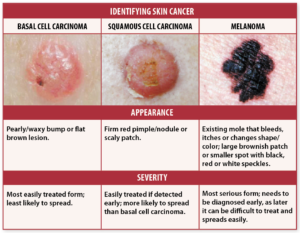Skin Cancer Signs? Self-Checks May Help You Avoid Deadly Recurrence
Complement self examinations with at least adequate sun protection to fend off the development of skin cancer.
Melanoma—the most serious form of skin cancer—is rare, but the number of cases is still cause for concern. According to the American Cancer Society, more than 87,000 people are diagnosed with melanoma every year, and nearly 10,000 die from the disease. Regular self-checks will help you recognize skin cancer signs early on and avoid serious consequences.
Arash Akhavan, assistant clinical professor of dermatology at Mount Sinai, says that melanoma is particularly lethal because it can spread rapidly to other organs, such as the lungs and liver. “But the disease has a 99 percent five-year survival rate if is caught and treated before it spreads to lymph nodes,” he adds. “Two other potentially serious types of skin cancer—basal cell carcinoma and squamous cell carcinoma—have cure rates approaching 95 percent if treated early.”
Risk of Recurrence
People who have survived one melanoma are about nine times as likely as the general population to develop a second, and this risk persists for years after their initial melanoma diagnosis. But a simple skin check could ensure swift treatment if melanoma recurs, according to researchers writing in the April issue of the Journal of the American College of Surgeons.
Dr. Akhavan agrees. “Skin cancer isn’t hidden deep within the body: we don’t need imaging tests to detect it,” he says. “It is visible on the skin, and can be detected by the naked eye.”The study analyzed data on 581 people with early-stage melanoma and at least one year of follow-up. Of those, 171 developed a recurrence, with 40 percent of these new melanomas spotted by patients. Doctors identified 30 percent of recurrent melanomas, and 26 percent were detected with imaging scans.
Another recent study (JAMA Oncology, Feb. 23) suggests that if full-body skin cancer screenings became a part of routine annual primary care visits, significantly more skin cancers would be discovered—and at earlier stages. In the study, the melanomas discovered in screened patients were thinner than those of the unscreened patients. “Melanoma thickness is an important predictor of mortality risk in patients,” Dr. Akhavan notes. “The thinner the cancer, the more likely it can be completely removed, and the less likely it is to have spread.”
Regular Body Check May Catch Skin Cancer Signs
Dr. Akhavan says it’s a good idea to schedule a yearly body check with a dermatologist (get one every six months if you’re high risk), and to do a monthly head-to-toe self-check at home.
Set 10 to 15 minutes aside each month for your self-check, and perform it in front of a full-length mirror in good light. Check every part of your skin, including your scalp, underneath your breasts, fingernails, and toenails, soles of the feet, and in between your toes. Use a hand mirror to check your back and genitals.
SKIN CANCER: KEEP A CLOSE EYE
Follow the ABCDE rule when examining suspicious moles:
- Asymmetry: The shape of one half doesn’t match the other.
- Border: A ragged or blurred edge.
- Color: Shows uneven color—shades of brown, black, tan, red, white or blue.
- Diameter: A significant change in size that takes the diameter of the mole higher than six millimeters.
- Evolving: Anything changing or evolving needs to be seen by a dermatologist.
Protection Also Vital to Avoid Skin Cancer Signs and Symptoms
If you’re spending time in the sun, always use sunscreen to protect exposed skin. Up to 40 percent of Americans skip this basic preventive measure. Yet it’s vital to use sunscreen with a sun protection factor (SPF) of at least 15 and preferably 30, and to use enough of it; it’s thought that most people use less than half of the recommended amount.
Dr. Akhavan recommends you use at least an ounce (enough to fill a shot glass) to cover any exposed skin, including your ears, lips, the back of your neck, and your scalp if your hair is thinning. “Apply the sunscreen 15 to 30 minutes prior to sun exposure so it has time to become active before you go out,” he advises. “Seeking shade during the sunniest hours of 10 a.m. to 4 p.m., and wearing protective clothing, are other vital components of an effective sun protection regimen.”
For more on skin cancer signs, causes, symptoms, and treatment, please see these University Health News posts:



 Savor the Sweet Potato
Savor the Sweet Potato  Swollen Lymph Nodes in Your Neck: What You Need to Know
Swollen Lymph Nodes in Your Neck: What You Need to Know  Are UV Nail Lamps Safe? Ultraviolet Light and Cancer
Are UV Nail Lamps Safe? Ultraviolet Light and Cancer 
Regular self-exams will lead you to any suspicious spots on your body—and no doubt prompt you to a dermatologist for an examination.
© Wavebreakmedia Ltd | Dreamstime.com